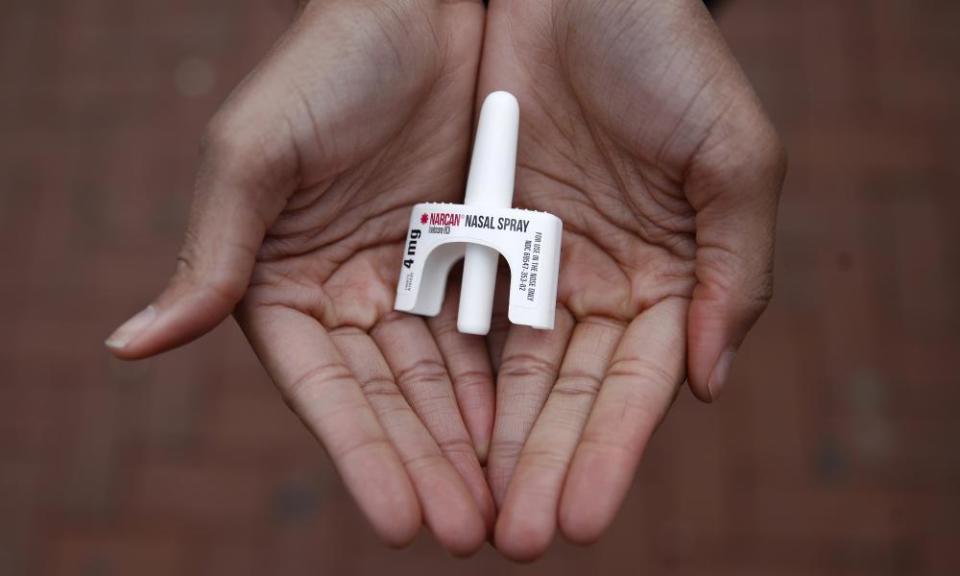‘It’s a different beast’: US fentanyl deaths will rise, warns Narcan developer

Deaths from fentanyl will continue to rise and overdoses may be increasingly difficult to battle in the US, said Roger Crystal, who helped develop Narcan nasal spray, an easy-to-use medication that reverses overdoses.
The overdose crisis that killed more than 100,000 Americans in one year is “all about fentanyl”, Crystal said – and it’s only going to get worse.
Related: ‘It’s devastating’: how fentanyl is unfolding as one of America’s greatest tragedies
Those who are overdosing from fentanyl have a shorter window of time to be saved and may need additional doses of the medication.
“Fentanyl is an opioid, but it’s a different beast entirely. It acts faster, it’s much stronger, and it lasts longer,” Crystal told the Guardian. That means overdose reversals need to happen faster, and multiple doses of naloxone may be needed. Sometimes, he said, a person is revived with one dose, but falls back into an overdose again because of fentanyl’s long-lasting effects.
Frequently, people don’t realize they have taken fentanyl, because it’s mixed in with other drugs or it’s pressed to look like legitimate prescription pills. And even stronger synthetic opioids – like carfentanil, which is 100 times more potent than fentanyl – are also entering the market. “I call it supercharged fentanyl,” Crystal said. “It’s just frightening and staggering.”
Narcan is an inhalable form of naloxone, which was first patented in 1961. Now naloxone is available as a generic, but Narcan nasal spray is patented.
This year, harm reduction organizations faced a huge increase in the cost of life-saving naloxone treatments. The pharmaceutical company Pfizer has provided the organizations with injectable naloxone at a very low cost, but due to manufacturing problems, had to cut back on supply for several months.
The other available naloxone options are 15 to 30 times more expensive. Harm-reduction advocates unsuccessfully called on companies like Emergent BioSolutions, the company that now makes Narcan, to lower the price temporarily as organizations working on the front lines of the opioid crisis witnessed thousands more deaths than the year before.
Crystal, who is the CEO of Opiant Pharmaceuticals, rejected the idea that Narcan’s price tag is making it difficult to save lives. “How cheap do you want a life-saving drug to be?” he argued.
Yet he acknowledged the growing force of the crisis in the United States, which is an international leader in opioid use and overdose deaths.
Right now, most fentanyl comes into the US from Mexico or China. But the synthetic opioid can be made in a lab anywhere, making it difficult for authorities to limit the supply – unlike, for instance, heroin, which is sourced from opium poppies that need to be grown.
“Fentanyl doesn’t have to come from overseas; we could make it here in the US. And it wouldn’t take much more than a competent chemist to be able to do so,” Crystal said. For now, it’s been cheaper to import it, but simply cracking down on imports would not be enough to eradicate the drug.
Instead, advocates are calling for better support – including treatment options for those with substance use disorder, inexpensive test strips to detect the presence of fentanyl, and a wide-scale, steady supply of affordable overdose-reversing medication.
Supervised injection sites, where naloxone can be administered immediately, and a safe supply for those with substance use disorder, would also cut down on countless deaths, researchers say.
Before working in the pharmaceutical industry, Crystal worked as a surgeon in London, and he saw many of the lasting complications of the opioid crisis.
“You can do, as the surgeon, the most fantastic surgical repair of a patient and really feel you’ve made a huge difference in saving their life,” he said. “But the sad fact is, the same patients would still come back to the ER later with something else, and then that made me realize, well, we’re not really treating the actual problem here.”

 Yahoo Movies
Yahoo Movies 